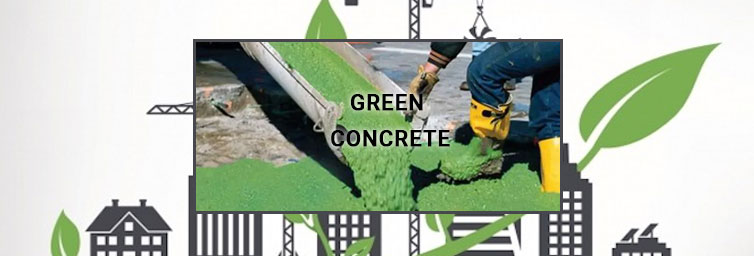You have no items in your shopping cart.
Post Requirement
In the history of the construction industry, Green Concrete is an advanced topic, which was developed first in Denmark in the year 1998.
The global warming gas CO2 emissions, 8 to 10% of the total come from manufacturing cement. The gas is released due to the crushing of limestone and clays and heated at high temperatures. There is a huge need to find a replacement to overcome this problem and solution to some extent is "Green Concrete".
What is Green Concrete?
It is the concept of using eco-friendly materials in concrete to make the construction system more sustainable.
It defines using raw material which production process does not lead to environmental damages and should have high performances and life cycle sustainability.
Objectives of Green Concrete
The three main objectives of green concrete are
• To reduce greenhouse gas emission i.e., carbon dioxide emission from the cement industry.
• To reduce the use of natural resources such as limestone, clay, shale, natural river sand, natural rocks that are being consumed for making conventional concrete.
• To reduce the use of waste materials in the concrete that results in air, land and water pollution.
Why Green Concrete?
The name itself says it is eco-friendly and saves the environment by using industrial waste products as a partial substitute for cement, natural sand and coarse aggregates.
It has substantial strength and durability than conventional concrete. It has exceptional resistance to corrosion and also withstands acid rains effectively. The buildings constructed with green concrete utilizes less energy as they are more resistant to temperature changes, thus saving heating and cooling costs.
The impact of global warming reduces to some length by switching completely to green concrete for constructions.
Materials used for Green Concrete
Reusable or Recyclable materials that can be easily dismantled and can be used after its life cycle are the materials used in the process of making green concrete. The examples of such materials are recycled concrete aggregates, recycled demolition waste aggregates, glass aggregates, fly ash, blast furnace slag, manufactured sand, rice husk ash, silica fume and metakaolin.
Uses of Green Concrete
It is used in the construction of buildings, dams, columns, bridges and roads.
Advantages of Green Concrete
Changes required for the preparation of green concrete is less compared to conventional concrete. It possesses better thermal & acid resistance and compressive & split tensile strength. The consumption of cement is less, thereby reducing carbon dioxide emissions. It is economical and has better workability than conventional concrete.
Disadvantages of Green Concrete
Green concrete structures have less life span compared to conventional concrete structures. Compressive strength and Flexural strength are less. Water absorption, shrinkage and creep are high. Use of stainless steel is more which increases the cost of reinforcement.
Conclusion
Various efforts have been conducted worldwide to find some alternatives that can significantly reduce high energy consumption and environmental impacts during the fabrication process of cement. The researchers have found that using green concrete is the solution to some extent which protects the environment and improves life cycle sustainability. The scope of green concrete in our country is more in future, but it does take more time to adopt.
You May Also Like to Read: Benefits of Green Buildings in Construction
Technically Reviewed by Rajesh Pagadala, MS, Founder & CEO - BuildersMart. Written by Vani paspula, Content Manager.
Vani Paspula













